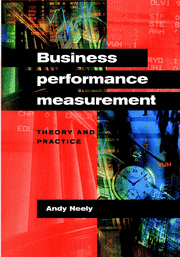Book contents
- Frontmatter
- Contents
- List of contributors
- Preface
- Part I Performance measurement – functional analyses
- Part II Performance measurement – theoretical foundations
- Part III Performance measurement – frameworks and methodologies
- Part IV Performance measurement – practical applications
- Part V Performance measurement – specific measures
- Part VI Performance measurement – emerging issues and trends
- 20 The future of performance measurement: Measuring knowledge work
- 21 Measuring eBusiness performance
- Index
21 - Measuring eBusiness performance
from Part VI - Performance measurement – emerging issues and trends
Published online by Cambridge University Press: 06 July 2010
- Frontmatter
- Contents
- List of contributors
- Preface
- Part I Performance measurement – functional analyses
- Part II Performance measurement – theoretical foundations
- Part III Performance measurement – frameworks and methodologies
- Part IV Performance measurement – practical applications
- Part V Performance measurement – specific measures
- Part VI Performance measurement – emerging issues and trends
- 20 The future of performance measurement: Measuring knowledge work
- 21 Measuring eBusiness performance
- Index
Summary
Measuring eBusiness performance: Key findings
In the first quarter 2000 members of both Accenture's Managing With Measures team and the Centre for Business Performance at Cranfield School of Management began a study of performance measurement in the new economy. During the course of the investigation senior managers from over 70 bricks-and-mortar, clicks-and-mortar and dot. coms offered their views and opinions on the strengths and weaknesses of their organization's performance measurement systems. The ten key findings of the study were:
1 Everyone wants to improve their organization's measurement systems. Despite the vast time and effort that many management teams have exerted on their measurement systems over the last few years, still there is immense frustration. Survey respondents from 96 percent of bricks-and-mortar, 96 percent of clicks-and-mortar, and 100 percent of the dot. coms said they wanted to improve their measurement systems.
2 When it comes to performance measurement, the dot. coms have different improvement priorities to the bricks-and-mortar and clicks-and-mortar firms. While everyone wants to develop more comprehensive strategic measurement systems, the dot. coms are also particularly interested in using technology to track performance – especially for click stream analysis and customer relationship management.
3 Everyone understands the importance of measuring customer satisfaction. One hundred percent of those surveyed said either that they measured customer satisfaction or that they should measure it.
[…]
- Type
- Chapter
- Information
- Business Performance MeasurementTheory and Practice, pp. 343 - 360Publisher: Cambridge University PressPrint publication year: 2002
- 6
- Cited by



